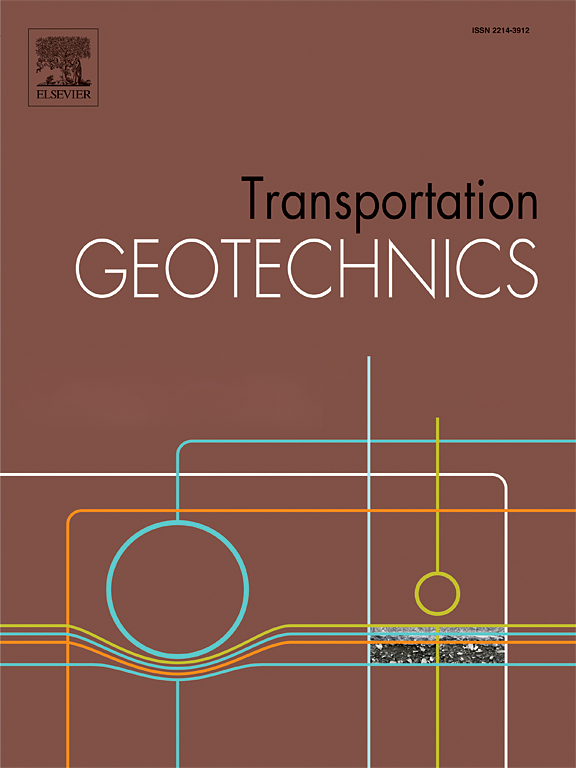Investigating the particle size effect of calcareous sand using a critical state-based model with the covariance matrix adaptation evolutionary strategies algorithm optimization
IF 4.9
2区 工程技术
Q1 ENGINEERING, CIVIL
引用次数: 0
Abstract
The particle size of natural calcareous sands (CSs) varies significantly. It is of great interest for engineering practice if the mechanical behaviours of coarse-grained CSs can be easily extended from behaviours of fine-grained CSs using a constitutive model, for which the size effect is the key issue. For this purpose, consolidation-drained triaxial shear test results on CSs with five varying particle sizes were first re-interpreted to reveal this effect. The critical state-based constitutive model of sand (SIMSAND model) considering particle breakage effect was adopted for describing the mechanical behaviours of CSs. The optimization theory with the algorithm of covariance matrix adaptation evolutionary strategies (CMA-ES) was integrated with SIMSAND for identifying model parameters of five CSs. The applicability of the SIMSAND model to CS and the rationality of the CMA-ES algorithm in determining model parameters were thus verified. Then, six size-dependent parameters were selected according to the model parameter analysis of five CSs. Six relationships between the size-dependent parameters and the particle size were proposed based on three CSs, together with which the SIMSAND model can consider both particle size and breakage effects. The model’s rationality was further validated by simulating tests of another two CSs (one for interpolation and the other for extrapolation). The findings can lay a foundation for the prediction of mechanical behaviours in CSs with varying particle sizes.
基于协方差矩阵自适应进化策略的临界状态模型研究钙质砂粒径效应
天然钙质砂(CSs)的粒径差异很大。如何利用本构模型将粗粒度CSs的力学行为从细粒度CSs的力学行为扩展到粗粒度CSs的力学行为,对工程实践具有重要意义,其中尺寸效应是关键问题。为此,首先重新解释了5种不同粒径CSs固结排水三轴剪切试验结果,以揭示这一效应。采用考虑颗粒破碎效应的基于临界状态的砂土本构模型(SIMSAND模型)来描述CSs的力学行为。将基于协方差矩阵自适应进化策略(CMA-ES)算法的优化理论与SIMSAND相结合,识别了5种CSs的模型参数。验证了SIMSAND模型对CS的适用性以及CMA-ES算法确定模型参数的合理性。然后,根据5个CSs的模型参数分析,选择6个尺寸相关参数。基于3种CSs,提出了粒径相关参数与粒径之间的6种关系,使得SIMSAND模型可以同时考虑粒径和破碎效应。通过模拟另外两个CSs(一个用于插值,另一个用于外推)的测试,进一步验证了模型的合理性。研究结果为预测不同粒径CSs的力学行为奠定了基础。
本文章由计算机程序翻译,如有差异,请以英文原文为准。
求助全文
约1分钟内获得全文
求助全文
来源期刊

Transportation Geotechnics
Social Sciences-Transportation
CiteScore
8.10
自引率
11.30%
发文量
194
审稿时长
51 days
期刊介绍:
Transportation Geotechnics is a journal dedicated to publishing high-quality, theoretical, and applied papers that cover all facets of geotechnics for transportation infrastructure such as roads, highways, railways, underground railways, airfields, and waterways. The journal places a special emphasis on case studies that present original work relevant to the sustainable construction of transportation infrastructure. The scope of topics it addresses includes the geotechnical properties of geomaterials for sustainable and rational design and construction, the behavior of compacted and stabilized geomaterials, the use of geosynthetics and reinforcement in constructed layers and interlayers, ground improvement and slope stability for transportation infrastructures, compaction technology and management, maintenance technology, the impact of climate, embankments for highways and high-speed trains, transition zones, dredging, underwater geotechnics for infrastructure purposes, and the modeling of multi-layered structures and supporting ground under dynamic and repeated loads.
 求助内容:
求助内容: 应助结果提醒方式:
应助结果提醒方式:


